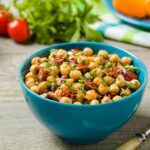by: November 9, 2024
 (NaturalHealth365) With an astonishing two out of three American adults currently either overweight or obese, the need for natural methods of weight control has never been more urgent. So, today, we feature an interesting study – that shows that chickpeas, also known as garbanzo beans, can help combat obesity by reducing food cravings and contributing to a feeling of fullness.
(NaturalHealth365) With an astonishing two out of three American adults currently either overweight or obese, the need for natural methods of weight control has never been more urgent. So, today, we feature an interesting study – that shows that chickpeas, also known as garbanzo beans, can help combat obesity by reducing food cravings and contributing to a feeling of fullness.
Chickpeas, a type of legume popular in Mediterranean, Middle Eastern, and African cuisines, is also a staple of the Ayurvedic healing diet. Now, researchers are learning how this tasty, versatile bean can help fight heart disease and support digestive health.
Eating chickpeas will have a POSITIVE effect on your appetite for high-calorie junk foods
One of the chickpea’s secret weapons against hunger is its high content of soluble fiber, which slows gastric emptying, helps to prevent erratic blood sugar “spikes,” and provides a feeling of fullness. In addition, chickpeas are rich in protein, which provides more feelings of fullness per calorie than carbohydrates or fat.
Perhaps most importantly, chickpea consumption can decrease the production of ghrelin, a hormone that sharpens appetite and increases hunger. The name “ghrelin,” which evokes the terms “gremlin” and “villain,” is appropriate. When it comes to stimulating excessive hunger and triggering weight gain, ghrelin seems to be both!
To be clear, scientific research has supported the ability of chickpea consumption to promote weight loss. In an Australian study published in Appetite, participants were instructed to eat their normal diets, with the addition of four ounces a day of chickpeas. The volunteers – who were not encouraged to restrict their caloric intake in any way – reported eating less, feeling fuller, and consuming fewer high-calorie, highly processed foods, although they were not making a conscious attempt to do so.
However, these benefits vanished when the participants entered the study’s final (chickpea-free) period. Clearly, chickpea consumption encourages wiser food choices.
But there’s more to this story.
In an additional study, legumes (such as chickpeas) helped obese volunteers on a calorie-restricted diet lose more weight than the control group. Consumption of legumes was associated with a 7.7 percent decrease in weight, as compared to 5.3 percent in the control group. As a bonus, the chickpea group experienced reduced oxidized LDL.
Finally, chickpeas contain a fermentable fiber known as raffinose. Raffinose has prebiotic effects, meaning that it promotes gut health by providing food for beneficial bacteria in the gastrointestinal tract.
So, it’s not surprising that the participants in the Australian study reported improvements in bowel function, as well.
Chickpeas fight heart disease on several different fronts
As you probably know, high circulating LDL cholesterol levels can oxidize and build up inside the walls of the arteries – setting the stage for inflammation, arterial plaque, and atherosclerosis).
But, chickpea polyphenols – such as quercetin and caffeic acid – not only decrease LDL cholesterol but make existing amounts less vulnerable to oxidation.
Research supports the ability of chickpeas to combat heart disease. In one study, half a cup of chickpeas a day for eight weeks caused LDL levels to fall by 17.1 percent.
Chickpeas are also high in folate, also known as vitamin B9. This important nutrient works along with riboflavin (and other B vitamins) to lower levels of the amino acid homocysteine – elevated levels of which are implicated in inflammation and heart disease.
Finally, chickpeas are rich in magnesium, which helps maintain healthy blood pressure.
Chickpeas contain a jackpot of health-giving nutrients
With a firm, pleasing consistency and a nutty, buttery flavor, chickpeas provide an easy way to boost your dietary intake of essential nutrients.
A whole cup of boiled chickpeas provides a reasonable 269 calories – considering how much high-quality nutrition they provide. The same serving also contributes an impressive 14.5 grams of protein and 12.5 grams of fiber.
Chickpeas also offer a whopping 84 percent of the recommended daily value of manganese – needed for the metabolism of fat and carbohydrates – 71 percent of folate and 20 percent of magnesium. They also provide about a quarter of the daily value of iron, containing potassium and zinc, in good supply. In addition to folate, they contain other B complex vitamins – such as B1 (thiamine), B2 (riboflavin), and B5 (pantothenic acid) – along with vitamin K, vital for healthy blood clotting and strong bones.
Add tasty, versatile chickpeas to the menu
Chickpeas are a key ingredient in hummus, and it’s not hard to make your own. Combine mashed organic chickpeas with lemon juice, garlic, olive oil, cayenne, or red pepper for extra flavor and color (and antioxidant carotenoids.)
You can also add chickpeas to salads, sprinkle them in soups, or lightly roast for a crunchy, satisfying snack. To prepare dried garbanzo beans, rinse them and soak for 12 hours. Then boil briefly, lower heat, cover, and simmer until tender – usually for about an hour.
For those ‘in a hurry,’ there are canned chickpeas. But, keep in mind, to avoid toxic chemicals – opt for organic chickpeas and rinse them well to remove excess sodium.
Anti-obesity, heart-protective, prebiotic, and anti-inflammatory chickpeas manage to “check every box” as a super food. So, adding these beneficial legumes to your diet will be a wise (and delicious!) move.
Sources for this article include:
No hay comentarios:
Publicar un comentario